Terry Collins

The worst thing that can happen to the Mets is them losing one of their pitchers for any period of time. With Matt Harvey‘s undisclosed and unknown medical situation, this fear is now a reality.
The scary part about it is how it has escalated. First, the Mets assumed he was hung over. Then, they thought it wouldn’t prevent him from making his next Spring Training start. Now, he’s flying back to New York for further examination. He’s most likely going to miss Opening Day. The players don’t know what’s going on, and they are praying for him.
The only thing we do know is Harvey’s arm is fine, or as only Terry Collins can put it, “His arm is fine! His arm is fine! Ok? His arm is fine.” This is leading to speculation as to what is wrong with Harvey, and there is no shortage of opinions.
This is because no one knows what’s happening. Part of that is HIPAA laws. Part of that is the Mets making an announcement before having all of the information. A large part of it is Harvey’s Bravo appearance and general assumptions fans have about him.
Hopefully, this is a relatively minor issue not only because of the Mets season, but more importantly, this is a man’s health we are talking about here. With that said, I’m reminded of other instances where a player’s health has postponed, derailed, or ended a player’s career.
As Mets fans, we have seen our fair share of problems. There was Ike Davis‘ bout with Valley Fever. Jose Reyes was found to have a thyroid condition. Just last year, there was David Wright and his spinal stenosis diagnosis. Elsewhere, there have been far more life threatening medical issues.
Jon Lester battled lymphoma before coming back and winning the clincher of the 2004 World Series. Brian Picolo would go from an NFL player to dying from cancer. There was also the day fifteen years ago when Magic Johnson retired from the NBA when he discovered he contracted HIV.
We don’t know what Harvey’s medical issue is. We may never know. The only thing we do know is no one wants to see something happen that will not only forever alter Harvey’s career, but also his life. So while we know his arm is alright, we don’t know if he’s alright. We don’t know what, if any effect, this will all have on his career.
Like Travis d’Arnaud and the rest of the Mets, all we can do is pray that Harvey will be alright.
Editor’s Note: this article first appeared on metsmerizedonline.com

Last year, the seminal moment of the Spring was David Wright and Bobby Parnell throwing out Noah Syndergaard’s lunch. This year it was Dominic Smith‘s turn to learn a lesson.
This past weekend, Smith got a hold of one, and he thought it was out. He didn’t flip the bat or admire and pose after hitting it. No, he broke right into his homerun trot. He wasn’t hustling out of the box. When the ball hit the wall, Smith wound up with a single instead of a double.
A ten year veteran might get away with it. Not a AA player. It’s why Terry Collins approached him about the moment. For his part, Smith seemed to get it vowing he would never did it again. He said, “there’s no place for me not to hustle out of the box like that. It’s a learning experience.”
Look, this isn’t about taking fun out of the game. He wasn’t chastised for celebrating a homerun. The manager talked to him about a lack of hustle. It was fair for Collins to do so. Smith is a 20 year old kid with a lot of promise. It’s up to Collins in the little time they have together to help point out to Smith what we needs to do to take the next step.
Hustling out of the box is a fair and legitimate concern. It was never an issue for Smith before, and it probably won’t be in the future. However, Collins took advantage of an opportunity to talk to him. Smith will be a better player for it, which is saying something.
Hopefully, this moment will be Thor’s moment. It will be what we will be talking about one day during his rise to greatness.
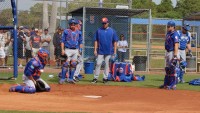
I don’t care what is happening. The Mets could be coming off a World Series appearance. The Mets could have traded everyone away in Marlins fashion. It doesn’t matter. It’s always good to see Mike Piazza with the Mets.
He’s back as a special instructor. He is there to work with Travis d’Arnaud and Kevin Plawecki. It makes sense to have a Hall of Fame catcher work with a budding All Star and prospect. Terry Collins intends gave Piazza more latitude than just working with the catchers. For example, Piazza took the time and the initiative to talk with Yoenis Cespedes about being a superstar in New York.
With his appearance at Spring Training, it did get me thinking about when and if Piazza would ever manage in the big leagues.
Right now, the Mets manager is Terry Collins, and there is no reason to believe that’s going to change soon. Collins received a two year extension. He supposedly wants to manage these next two years and then retire. The question them arises as to who the next Mets manager will be.
One trend that never seems to go away is hiring a former star to lead the team. Robin Ventura manages the White Sox. Paul Molitor manages the Twins. Ventura had no managing experience. Molitor had experience as a minor league instructor.
Piazza only has experience as the hitting coach for Team Italy. He has been well regarded in his work as the hitting coach. He has also worked with catchers and ran instructional clinics. This year has been his first year back at Spring Training with the Mets in two years. Most likely, this stint is the Mets inviting their Hall of Famer to spend time with the team. Who’s to say it can’t be more.
At one point in time, Piazza stated he envisioned returning to baseball in some capacity. He has always kept in touch with the Mets. As of right now, he’s enjoying his time, but he wants to let this team get ready for the season. He’s not overstaying his welcome. He seems content with a few days in Spring Training for now. Maybe with young children that’s all Piazza will ever want.
Two years is a long time. If Piazza wants to return to the Mets in a full time capacity, the door should always be open. No, they shouldn’t hand him a manager job. Still, there’s always room for a person with Piazza’s baseball acumen and ability to handle New York. He may just want to be a special instructor.
No matter what that future role may be, it’ll be great to see Piazza in a Mets uniform imparting his wisdom to the next generation of Mets players.

Overall, it’s hard to imagine a scenario where Yoenis Cespedes‘ 2016 season isn’t a disappointment. He’s expected to break Barry Bonds (or Roger Maris‘) single season homerun record, Hack Wilson‘s single season RBI record, and find a cure for cancer. Yes, this is hyperbole, but it’s really not that far from what’s being expected of him.
After his incredible run last year, Cespedes has set the bar sky high. When he came to the Mets, he played the best baseball of his life. It was some of the best baseball anyone has ever seen. More than anything, this has been the reason why he’s had all the attention surrounding him. If Tim Teufel had these cars, it would be an amusing antidote, but it wouldn’t be the focus of each and every day this Spring.
Look, the Cespedes’ car thing has been terrific. It’s added some fun to Spring Training. We’re talking about this instead of Terry Collins leaving in Matt Harvey, David Wright‘s back, Jacob deGrom tweaking his groin, Alejandro De Aza‘s possible discontent, or Roger Bernadina having visa issues. No, the Mets are having a fun camp in large part due to Cespedes.
That’s is unless you’re John Harper of the Daily News:
Just as Mets fans were quick to turn on Harvey during the innings-limit controversy last season, citing his look-at-me tendencies, they’ll tire quickly of hearing about Cespedes’ lifestyle if he doesn’t put up big numbers.
Same goes for the clubhouse. Teammates will gladly accept Stsr behavior as long as it comes with star performance. And certainly Cespedes has earned plenty of slack in this area, having astonished his fellow Mets with his offensive exploits last summer after coming over from the Tigers on July 31.
Why are we preemptively chastising Cespedes? Keep in mind, this is the same writer that despite knowing all of the “issues” Cespedes presents, he implored the Mets to re-sign him. Now that he’s here, what’s the point of tearing him down?
Cespedes was everything the Mets thought he would be and more last year. So far, he has been everything we thought he would be this Spring Training. It makes sense that the guy with the neon yellow arm sleeve and the 52 medallion would have an epic car collection. It makes more sense that Cespedes was going to be the focal point of this team no matter what he did. Why not have some fun along the way?
Look, his season is bound to be a disappointment. His 162 game averages are “only” 30 homeruns and 103 RBI. That’s not going to be enough for some people. That’s a shame because fans wanted Cespedes here, and he wanted to be here. No matter what Cespedes does this season that should be celebrated. Instead, the Daily News is already finding ways to tear him down.
These preemptive attacks should be driven off a cliff.
Editor’s Note: this column first appeared on metsmerizedonline.com
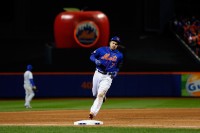
There is no more physically, psychologically, and intellectually demanding position than catcher.
The catcher needs to know the entire scouting report for the opposition at the plate and on the basepaths. The catcher needs to balance a hitter’s strength and weaknesses against his pitcher’s in calling a game. If a pitcher doesn’t have a pitch working, he has to create a new strategy on the fly. When a pitch is thrown, he has to do all he can to make sure the pitch is called a strike. Throughout the game, he has to keep the pitcher’s head in the game. It’s especially tough when the pitcher is getting squeezed.
When his team is up to bat, he needs to talk to the pitcher about the batters coming up the next inning. He needs to talk with the manager and pitching coach not only about that, but also how the pitcher is throwing and what he has left. By the way, at some point, he has to bat 4-4 times in a game to help put some runs on the board for the pitcher.
The catcher faces pitches in the dirt he has to eat up with any part of his body. He will get nicked with a foul tip or an errant swing. Runners try to take him out with a slide, or in very rare instances, he can get run over at home plate. The catcher is bound to have some bumps and bruises or trips to the DL. Even after a tough game, the catcher comes back and does it all tomorrow.
Even though all of this is gust the tip of the iceberg of a catcher’s responsibilities, how do most people judge the effectiveness of a catcher? Their effectiveness in throwing out potential base stealers.
It was the topic in John Harper’s New York Daily News column about Travis d’Arnaud‘s troubles throwing out baserunners in the postseason. Actually, to call it a difficulty is an understatement. Despite being better than league average in throwing out baserunners during the regular season, d’Arnaud struggled mightily in the postseason. Would be basestealers were a perfect 11/11 against him and the Mets pitching staff.
This was a major focus of Harper’s article. For his part, d’Arnaud readily admits that shouldn’t happen, and he says he needs to improve. It was an important enough issue for Terry Collins that he made it a point to take a part in the first throwing drills of Spring Training. There was talk of a need to improve d’Arnaud’s mechanics and the like.
What was overlooked was that of the 11 people who stole a base against the Mets in the postseason, only one scored a run. A big reason why is that d’Arnaud excels in all the other areas of being a catcher.
Since he became the Mets catcher, d’Arnaud has been an excellent pitch framer. Last year, he led the majors in highest percentage of balls being called strikes. When there is a premium being placed on the pitch counts and innings pitched for this young staff, every strike d’Arnaud can steal is crucial. Furthermore, getting strikes called puts a pitcher in an advantageous position. This usually leads to shorter at bats and more outs.
Additionally, there is the subjective element of catching. The pitchers like throwing to him. They feel comfortable while he’s behind the plate. He instills confidence in his staff.
By the way, he’s also a terrific hitter. He was the second best offensive catcher in baseball last year. In the NLCS, he hit a homerun off of the Homerun Apple. d’Arnaud hit it so hard, the apple needed a bandaid.
So overall, d’Arnaud does everything you could ever want your catcher to do. He has the confidence of his pitching staff. He gets the pitches called for strikes. He is a good hitter. Basically, d’Arnaud comes to beat you in multiple ways each and every day. If he struggles for a stretch with throwing out baserunners, there are other parts of his game that overshadow it, that help to prevent that run from scoring.
d’Arnaud may struggle throwing out people again next year. That’s fine. As long as he keeps doing what he’s doing, he will still be a terrific all-around catcher. He will help the Mets return to the postseason and win the World Series.
Editor’s Note: this article first appeared on metsmerizedonline.com

At this point, I’m simply in awe of this Mets team. It’s not the pitching. It’s not the power from the lineup. No, it’s the collection of the fine men they’ve assembled on this team:
Terry Collins stopped practice to have the pitchers meet Ryan Williams who had a heart transplant. #LoveTheMets #LGM pic.twitter.com/S95OLuJRPI
— New York Mets (@Mets) February 23, 2016
Moments like this start with Terry Collins, who has time and time again proven himself to be a good man. Last year, he hand wrote a letter to a grieving family. He celebrated each victory with his team and the fans. Terry Collins gets it, and he makes sure his players get it as well.
In 2016, Terry Collins will drive us crazy with his moves. He will cost the Mets games as he has done in the past. When that happens, I’m going to be upset. I’m going to utter more than a few expletives. I’ll calm down because Terry Collins is the right man to lead this Mets team. He brings the best out of his players both on and off the field.
This is why the Mets stop to pose for a picture with a young fan that just had a life saving operation. It’s why the team does any number of things they do off the field we will never hear mentioned. This team gets it, and they do the right thing.
As Mets fans, we’re lucky to have Terry Collins leading this team.
Editor’s Note: this article first ran on metsmerizedonline.com
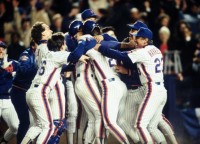
I remember back in 2000, the stories were that Bobby Valentine needed to make the World Series in order to keep his job. The amazing thing is he actually did it.
Just think about everything that had to happen that year for the Mets to make the World Series. First, the Mets had an overhaul of its outfield during the season. On Opening Day, the Mets outfield was, from left to right, Rickey Henderson–Darryl Hamilton–Derek Bell. At the end of the year, it was Benny Agbayani–Jay Payton-Derek Bell. Agbayani was only on the Opening Day roster because MLB allowed the team to have expanded rosters for their opening series in Japan.
On top of that, Todd Zeile was signed to replace John Olerud. Zeile had to become a first baseman after playing third for 10 years. Edgardo Alfonzo had to adapt from moving from the second spot in the lineup to the third spot. The Mets lost Rey Ordonez to injury and first replaced him with Melvin Mora for 96 games before trading him for the light hitting Mike Bordick. More or less, all of these moves worked. Then came the postseason.
A lot happened in the NLDS. After losing Game One, the Mets faced a quasi must win in Game Two. They were leading before Armando Benitez blew a save. I know. I’m shocked too. The Mets regained the lead, and they won the game when John Franco got a borderline third strike call against Barry Bonds. In Game Three, the Mets won on a Agbayani 13th inning walk off homerun. This was followed by Bobby Jones closing out the series on a one-hitter.
The Mets were then fortunate that the Braves lost to the Cardinals in the other NLDS series. The Mets tore through the Cardinals with new leadoff hitter Timo Perez. We saw all that luck run out in the World Series. We watched Zeile’s potential homerun land on top of the fence and bounce back. On the same play, Perez was thrown out at home. In the same game, Benitez blew the save. Unfortunately, there were no more heroics.
We saw this repeated in 2015. The epically bad Mets offense had to have its pitching hold things together until help came. Part of that required the Nationals to underperform while the Mets were fighting tooth and nail just to stay in the race.
In the NLDS, the Mets were on the verge of elimination. They weren’t eliminated because somehow, some way Jacob deGrom pitched six innings with absolutely nothing. The Mets then needed Daniel Murphy to have a game for the ages. He stole a base while no one was looking, and he hit a big homerun. It was part of an amazing run through the postseason for Murphy. Like in 2000, it came to a crashing halt in the World Series.
No matter how good your team is, it takes a lot of luck to win the World Series. Look at the 86 Mets.
In the NLCS, they barely outlasted the Astros. In Game Three, they needed a Lenny Dykstra two run homerun in the bottom of the ninth to win 6-5. In Game Five, Gary Carter hit a walk off single in the 12th to send the Mets back to Houston up 3-2. It was important because they didn’t want to face Mike Scott and his newfound abilities. With that pressure, they rallied from three down in the ninth, blew a 14th inning lead, and nearly blew a three run lead in the 16th inning.
Following this, the Mets quickly fell down 0-2 in the World Series before heading to Boston. After taking 2/3 in Boston, the Mets had to rally in the eighth just to tie Game Six. There are books that can be written not only about the 10th inning, but also Mookie Wilson‘s at bat.
First, they had to have a none on two out rally with each batter getting two strikes against them. For Calvin Schiraldi to even be in the position to meltdown, he had to be traded by the Mets to the Red Sox heading into the 1986 season. In return, the Mets got Bobby Ojeda, who won Game Three and started Game Six. John McNamara removed Schiraldi way too late and brought in Bob Stanley. His “wild pitch” in Mookie’s at bat allowed the tying run to score. You know the rest:
By the way, keep in mind Bill Buckner wasn’t pulled for a defensive replacement. Also, the Mets had to rally late from 3-0 deficit just to tie Game Seven.
We need to keep all of this is mind when setting expectations for the 2016 season. Terry Collins is right when he says World Series title or bust is unfair. We know way too much can happen between now and the World Series. Right now, the only goal should be winning the NL East. If the Mets do that, they have met their reasonable expectations. After that, the Mets are going to need a little luck to win the World Series.
Fortunately, the Mets are carrying a four leaf clover in the form of Matt Harvey, Jacob deGrom, Noah Syndergaard, and Jeurys Familia
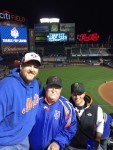
Terry Collins grew up watching baseball in an era when you had batting average, homeruns, and RBI to judge hitters. There was W-L record, ERA, and strikeouts to judge pitchers. Back then, utilizing the eye test was justifiable as there was no way to really quantify all you are seeing.
It’s important to keep this in mind when analyzing Terry Collins’ opinions on advanced statistics:
It’s become a young man’s game, especially with all of the technology stuff you’ve got to be involved in. I’m not very good at it. I don’t enjoy it like other people do. I’m not going to sit here and look at all of these [expletive] numbers and try to predict this guy is going to be a great player. OPS this. OPS that. GPS. LCSs. DSDs. You know who has good numbers? Good [expletive] players.
This quote reminds me of when I talk baseball with my Dad. He’s actually two years older than Terry Collins.
Whenever I talk to my Dad about baseball, I sometimes refer to advanced statistics. I will refer to WAR, FIP, UZR, etc. When I refer to them, he looks at me incredulously. He doesn’t know what they are. He doesn’t understand them. He asks me how to calculate them. I will give him a cursory explanation, but I can’t give him the exact formula. He can’t sit down and calculate it with his calculator. He’d rather talk about the statistics in which he’s more conversant.
The strange thing is I became interested in part due to my Dad. Growing up, he always told me to take W-L record with a grain of salt. He told me OBP was more important than batting average. He told me this in the 80’s! Back then merely suggesting that was heresy.
Now, we’re well beyond OBP and ERA being the advanced statistics to analyze. In many ways, Terry Collins is right. The game of baseball has passed them by. These newfangled statistics really are for a younger generation. Yet, we can all still enjoy baseball in our own way.
We don’t really need advanced statistics to tell us Matt Harvey is a really good pitcher. Yes, advanced statistics will support that conclusion. I love sitting there and watching games with my Dad. I remember in 2013 when he said that he expected Matt Harvey to throw a no-hitter every time he goes out to pitch. One night, we were there when it almost happened.
I love hearing my Dad tell me about how impossibly great Tom Seaver was. I love hearing him tell me that despite that he wanted Jerry Koosman on the mound for a big game.
So yes, how we analyze the game has changed since my Dad was a kid. Not to mention that teams are even trained differently from the days of old, with new technology and tools like the baseball swing trainer V2 and others available for anyone who aspires to be a solid player. It still doesn’t mean he doesn’t know a great player when he sees one. It doesn’t mean he doesn’t have a wealth of knowledge when it comes to the game of baseball. It doesn’t mean I don’t love talking baseball with him.
There will come a time when there are new statistics I won’t understand. I’ll be too old and set in my ways to learn the new ones. My son will roll his eyes at me when I refer to someone’s WAR or UZR. There’s going to be new statistics that will make all I think I know obsolete. That’s fine as long as we’re talking baseball (hopefully about his career). That’s all that matters.
No matter what happens, no matter what new statistics arise, the game never passes you by. As long as there are fathers and sons talking baseball, the game will belong to each and every generation. It will be a shared experience.
With that said, hopefully one day, my son will be able to explain to me what LCS and DSD is before I begin ignoring all thess newfangled statistics.
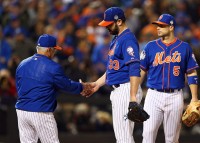
One of the many topics of this offseason has been about how all the Mets players love the team and how they want to stay here. Jacob deGrom said he would sign an extension. Now, it’s Matt Harvey‘s turn:
Matt Harvey said extension talk has never come up with the #Mets, but he hasn't "shied away" from it.
— Adam Rubin (@AdamRubinMedia) February 15, 2016
No, it’s not exactly a ringing endorsement. However, to me it’s a clear sign that he really is willing to sign an extension. Following Harvey’s career, there is no reason to believe otherwise.
Long before Harvey was drafted and became a part of the Mets organization, he was drafted by the Angels right out of high school. His association with Scott Boras raised questions about his signability. It caused him to slip to the third round. He informed the Angeld he would not sign unless he had a $2 million signing bonus. He would not accept $1.99 million. Accordingly, he would not accept the $1 million the Angels ultimately offered. Harvey rejected it despite his father telling him to take it, and he enrolled at the University of North Carolina.
Reading this, you may be led to believe that Harvey is just doing whatever Boras tells him to do. That premise should’ve been disproven after last year.
In 2012, Stephen Strasburg returned from Tommy John surgery, and he was famously shut down prior to the postseason. That decision was made when Scott Boras and GM Mike Rizzo agreed to Strasburg’s inning limits. Once Strasburg hit those limits, he was shut down. Boras tried to similarly intervene with Harvey.
As the timeline shows, Boras tried to get the Mets to limit Harvey to 180 innings. The main hurdle to that was it wasn’t what Harvey wanted to do. Instead of working with Sandy Alderson and Scott Boras, Harvey talked with his manager. It was Harvey and Terry Collins together that decided what Harvey needed to do. Harvey pitched more in September than the Mets, or Boras for that matter, thought he would pitch.
For better or worse, Harvey has always been in charge of his own career. It seems that on the field, he wants to compete at the highest level. For these actions, Harvey wants to be paid what he thinks he’s worth and not one penny less. That’s why Boras is his agent. He hired the guy who has a reputation of getting teams to pony up top dollar for the players he represents.
As noted by Adam Rubin today in his Morning Briefing, the belief that Boras’ clients don’t sign extensions prior to their hitting free agency is not entirely true. As Rubin notes, twenty-four of Boras’ clients have signed extensions with their teams before reaching free agency. Ironically, one of them was Jered Weaver, who signed an extension with the Angels; the same Angels who couldn’t find an extra million to sign Harvey.
So yes, it’s entirely possible the Mets can sign Harvey to an extension prior to his hitting free agency. Prior to this offseason, I would’ve been extremely pessimistic about the possibilities. However, this offseason the Mets re-signed Yoenis Cespedes thereby proving anything is possible.
I don’t know the Mets chances of re-signing Harvey. The only thing I do know is that Harvey is not going to accept one penny less than what he thinks he’s worth no matter what his family or his agent says.
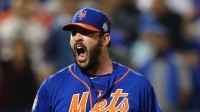
With Carlos Beltran giving his opinion on Terry Collins decision to send Matt Harvey back out for the ninth inning, I began to think of the different ways the Mets won or lost postseason series. Can you name the players involved in the last play in each of the Mets postseason series? Good luck!